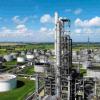I am assuming that the liquid that is boiling is not a pure component. If it is, then fire temperature is simply bubble point temperature of pure component and relieving pressure.
When component is not pure then this is not a straight forward answer. Different engineering standards have different guidelines on how to handle this.
The tricky part with this problem is that boiling fluid composition is not the same, thus vapour relief composition is changing as the fire progresses. The second part is that wetted area is also actually not the same. Things are very very dynamic in a fire and API calculation only deals with showing how to calculate the heat absorbed without showing you that actually heat absorbed results in different relief loads as things change during a fire and latent heat changes with composition.
So how to do this? One way is to use a simulator to do things iteratively. Now you have a wetted area and a volume of the liquid in the wetted area. You have also calculated heat absorbed by wetted area, Q.
Then do the following
(1) With a simulator and using the starting composition of the liquid at bubble point and a step time of 1min (you can change this), the heat absorbed will be Q * 1min.
(2) Use this heat as energy absorbed by the bubble pt liquid (enter the correct mass/volume based on holdup) and you will get a new temperature T1 plus vapour and a liquid stream. Put this through a flash drum. And you will get a new (heavier) liquid at bubble pt and a vapor stream relief properties. Check relief load and relief area required with this vapour stream in this step.
(3) Repeat step 2 with the same Q * 1min in step (1) on the new bubble pt liquid of step 2.
(4) Tabulate all the relief loads, relief area, and relief temperature and you will find that you will eventually find a maximum relief area. That should be the maximum design point.
(Note this assumes wetted area is almost constant throughout, you might want to re-evaluate if wetted area might change during the process)
The slides below show a slightly similar approach to the problem:
http://www.processen...ef_firecase.pdf
Edited by colt16, 14 March 2017 - 10:16 AM.

 FB
FB










